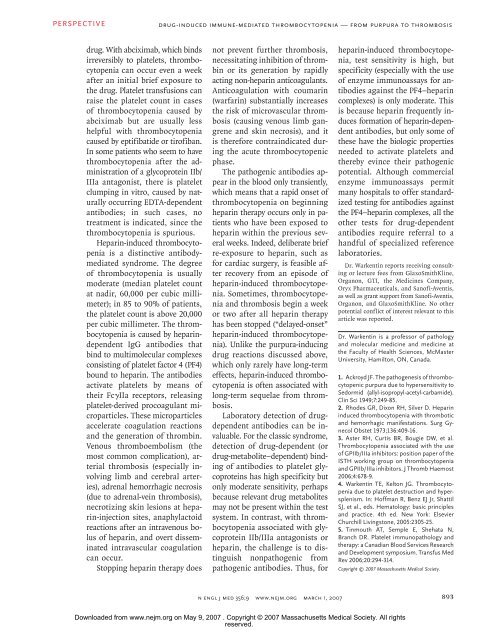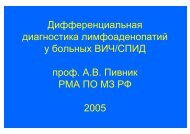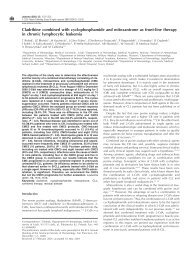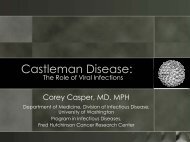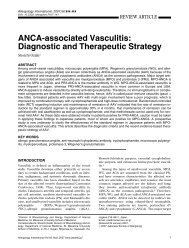Drug-Induced Immune-Mediated Thrombocytopenia ... - Hem-aids.ru
Drug-Induced Immune-Mediated Thrombocytopenia ... - Hem-aids.ru
Drug-Induced Immune-Mediated Thrombocytopenia ... - Hem-aids.ru
Create successful ePaper yourself
Turn your PDF publications into a flip-book with our unique Google optimized e-Paper software.
PERSPECTIVE<br />
<strong>D<strong>ru</strong>g</strong>-<strong>Induced</strong> <strong>Immune</strong>-<strong>Mediated</strong> <strong>Thrombocytopenia</strong> — From Purpura to Thrombosis<br />
d<strong>ru</strong>g. With abciximab, which binds<br />
irreversibly to platelets, thrombocytopenia<br />
can occur even a week<br />
after an initial brief exposure to<br />
the d<strong>ru</strong>g. Platelet transfusions can<br />
raise the platelet count in cases<br />
of thrombocytopenia caused by<br />
abciximab but are usually less<br />
helpful with thrombocytopenia<br />
caused by eptifibatide or tirofiban.<br />
In some patients who seem to have<br />
thrombocytopenia after the administration<br />
of a glycoprotein IIb/<br />
IIIa antagonist, there is platelet<br />
clumping in vitro, caused by naturally<br />
occurring EDTA-dependent<br />
antibodies; in such cases, no<br />
treatment is indicated, since the<br />
thrombocytopenia is spurious.<br />
Heparin-induced thrombocytopenia<br />
is a distinctive antibodymediated<br />
syndrome. The degree<br />
of thrombocytopenia is usually<br />
moderate (median platelet count<br />
at nadir, 60,000 per cubic millimeter);<br />
in 85 to 90% of patients,<br />
the platelet count is above 20,000<br />
per cubic millimeter. The thrombocytopenia<br />
is caused by heparindependent<br />
IgG antibodies that<br />
bind to multimolecular complexes<br />
consisting of platelet factor 4 (PF4)<br />
bound to heparin. The antibodies<br />
activate platelets by means of<br />
their FcγIIa receptors, releasing<br />
platelet-derived procoagulant microparticles.<br />
These microparticles<br />
accelerate coagulation reactions<br />
and the generation of thrombin.<br />
Venous thromboembolism (the<br />
most common complication), arterial<br />
thrombosis (especially involving<br />
limb and cerebral arteries),<br />
adrenal hemorrhagic necrosis<br />
(due to adrenal-vein thrombosis),<br />
necrotizing skin lesions at heparin-injection<br />
sites, anaphylactoid<br />
reactions after an intravenous bolus<br />
of heparin, and overt disseminated<br />
intravascular coagulation<br />
can occur.<br />
Stopping heparin therapy does<br />
not prevent further thrombosis,<br />
necessitating inhibition of thrombin<br />
or its generation by rapidly<br />
acting non-heparin anticoagulants.<br />
Anticoagulation with coumarin<br />
(warfarin) substantially increases<br />
the risk of microvascular thrombosis<br />
(causing venous limb gangrene<br />
and skin necrosis), and it<br />
is therefore contraindicated during<br />
the acute thrombocytopenic<br />
phase.<br />
The pathogenic antibodies appear<br />
in the blood only transiently,<br />
which means that a rapid onset of<br />
thrombocytopenia on beginning<br />
heparin therapy occurs only in patients<br />
who have been exposed to<br />
heparin within the previous several<br />
weeks. Indeed, deliberate brief<br />
re-exposure to heparin, such as<br />
for cardiac surgery, is feasible after<br />
recovery from an episode of<br />
heparin-induced thrombocytopenia.<br />
Sometimes, thrombocytopenia<br />
and thrombosis begin a week<br />
or two after all heparin therapy<br />
has been stopped (“delayed-onset”<br />
heparin-induced thrombocytopenia).<br />
Unlike the purpura-inducing<br />
d<strong>ru</strong>g reactions discussed above,<br />
which only rarely have long-term<br />
effects, heparin-induced thrombocytopenia<br />
is often associated with<br />
long-term sequelae from thrombosis.<br />
Laboratory detection of d<strong>ru</strong>gdependent<br />
antibodies can be invaluable.<br />
For the classic syndrome,<br />
detection of d<strong>ru</strong>g-dependent (or<br />
d<strong>ru</strong>g-metabolite–dependent) binding<br />
of antibodies to platelet glycoproteins<br />
has high specificity but<br />
only moderate sensitivity, perhaps<br />
because relevant d<strong>ru</strong>g metabolites<br />
may not be present within the test<br />
system. In contrast, with thrombocytopenia<br />
associated with glycoprotein<br />
IIb/IIIa antagonists or<br />
heparin, the challenge is to distinguish<br />
nonpathogenic from<br />
pathogenic antibodies. Thus, for<br />
heparin-induced thrombocytopenia,<br />
test sensitivity is high, but<br />
specificity (especially with the use<br />
of enzyme immunoassays for antibodies<br />
against the PF4–heparin<br />
complexes) is only moderate. This<br />
is because heparin frequently induces<br />
formation of heparin-dependent<br />
antibodies, but only some of<br />
these have the biologic properties<br />
needed to activate platelets and<br />
thereby evince their pathogenic<br />
potential. Although commercial<br />
enzyme immunoassays permit<br />
many hospitals to offer standardized<br />
testing for antibodies against<br />
the PF4–heparin complexes, all the<br />
other tests for d<strong>ru</strong>g-dependent<br />
antibodies require referral to a<br />
handful of specialized reference<br />
laboratories.<br />
Dr. Warkentin reports receiving consulting<br />
or lecture fees from GlaxoSmithKline,<br />
Organon, GTI, the Medicines Company,<br />
Oryx Pharmaceuticals, and Sanofi-Aventis,<br />
as well as grant support from Sanofi-Aventis,<br />
Organon, and GlaxoSmithKline. No other<br />
potential conflict of interest relevant to this<br />
article was reported.<br />
Dr. Warkentin is a professor of pathology<br />
and molecular medicine and medicine at<br />
the Faculty of Health Sciences, McMaster<br />
University, Hamilton, ON, Canada.<br />
1. Ackroyd JF. The pathogenesis of thrombocytopenic<br />
purpura due to hypersensitivity to<br />
Sedormid (allyl-isopropyl-acetyl-carbamide).<br />
Clin Sci 1949;7:249-85.<br />
2. Rhodes GR, Dixon RH, Silver D. Heparin<br />
induced thrombocytopenia with thrombotic<br />
and hemorrhagic manifestations. Surg Gynecol<br />
Obstet 1973;136:409-16.<br />
3. Aster RH, Curtis BR, Bougie DW, et al.<br />
<strong>Thrombocytopenia</strong> associated with the use<br />
of GPIIb/IIIa inhibitors: position paper of the<br />
ISTH working group on thrombocytopenia<br />
and GPIIb/IIIa inhibitors. J Thromb Haemost<br />
2006;4:678-9.<br />
4. Warkentin TE, Kelton JG. <strong>Thrombocytopenia</strong><br />
due to platelet dest<strong>ru</strong>ction and hypersplenism.<br />
In: Hoffman R, Benz EJ Jr, Shattil<br />
SJ, et al., eds. <strong>Hem</strong>atology: basic principles<br />
and practice. 4th ed. New York: Elsevier<br />
Churchill Livingstone, 2005:2305-25.<br />
5. Tinmouth AT, Semple E, Shehata N,<br />
Branch DR. Platelet immunopathology and<br />
therapy: a Canadian Blood Services Research<br />
and Development symposium. Transfus Med<br />
Rev 2006;20:294-314.<br />
Copyright © 2007 Massachusetts Medical Society.<br />
n engl j med 356;9 www.nejm.org march 1, 2007<br />
893<br />
Downloaded from www.nejm.org on May 9, 2007 . Copyright © 2007 Massachusetts Medical Society. All rights<br />
reserved.


